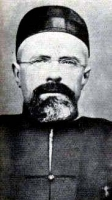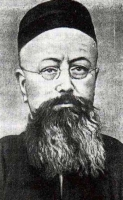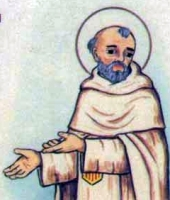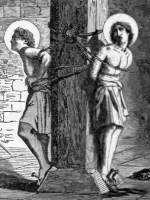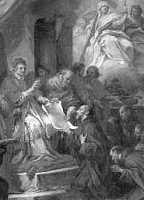St. Ursicinus of Ravenna
Feastday: June 19
Death: 67
Martyred physician. According to his unreliable Acts, he was a physician in Ravenna condemned for being a Christian during the persecution of Emperor Nero. His faith began to waver, but he found new strength through the encout agement of St. Vital is and met his death with resolve.
Saint Ursicinus of Ravenna (Italian: Sant' Ursicino) (d. ca. 67) is venerated as a martyr by the Catholic Church. He was said to be a physician of Ravenna. [1] His legend is connected with that of Saint Vitalis, who is said to have encouraged the wavering Ursicinus after the physician was sentenced to death for his faith. After he was beheaded, Vitalis buried him in Ravenna.[2]
He should not be confused with Bishop Ursicinus of Ravenna (6th century), who ordered the Basilica of Sant'Apollinare in Classe to be built.
Saint Romuald
தூய ரோமுவால்ட் (ஜூன் 19)
ரோமுவால்ட், இத்தாலியில் உள்ள ரவென்னாவில் 951 ஆம் ஆண்டு ஒரு செல்வச் செழிப்பான குடும்பத்தில் பிறந்தார். இவர் தன்னுடைய சிறு வயதில் எந்தவொரு கவலையும் இல்லாமல் சந்தோசமாக வாழ்ந்து வந்தார்.
இப்படிப்பட்ட சூழ்நிலையில் இவருடைய தந்தை, பக்கத்து வீட்டுக்காரரோடு இருந்த சொத்துத் தகராறில் அவரைக் கொன்றுபோட்டுவிட்டார். கொன்றுபோட்டதோடு மட்டுமல்லாமல், தனக்கு ஏதாவது ஆபத்து நேர்ந்துவிடுமோ என்று உயிருக்குப் பயந்து தலைமறைவானார். இதை நேரில் கண்ட ரேமுவால்ட் மனம் வருந்தினார். தன்னுடைய தந்தை செய்த தவற்றிற்கு பிராயச்சித்தம் செய்ய நினைத்தார். எனவே இவர் தூய ஆசிர்வாதப்பர் சபையில் சேர்ந்து துறவியாக வாழத் தொடங்கினார்.
சில காலம் அங்கிருந்து பயிற்சிகள் பெற்று துறவியாக வாழ்ந்து வந்த ரேமுவால்ட்டிற்கு மடத்தில் பின்பற்றப்பட்ட விதிமுறைகள் பிடிக்கவில்லை. அவை மிகவும் தளர்வாக இருக்கின்றன என்பதை உணர்ந்த இவர் மரினுஸ் என்பவரிடத்தில் சென்று பயிற்சி பெறத் தொடங்கினார்.
இதற்கிடையில் இவர் பல்வேறு நாடுகளுக்குச் சென்று நற்செய்தி அறிவிக்கவேண்டும் என்றெல்லாம் திட்டம் தீட்டினார். ஆனால் ஒவ்வொருமுறையும் இவர் ஒவ்வொரு நாட்டிற்கும் நற்செய்தி அறிவிக்கச் செல்லும்போது ஏதாவது ஒரு நோய் தாக்கி, அங்கு போகமுடியாத சூழ்நிலை ஏற்பட்டது. இதனால் இவர் அயல்நாடுகளுக்குச் சென்று நற்செய்தி அறிவிப்பது தனக்குச் சரிப்படாது என நினைத்து கமல்டோலி என்னும் இடத்தில் துறவற மடம் ஒன்றை நிறுவி அங்கே கடுந்தவம் செய்து, ஜெபத்தில் தன்னை முழுமையாய் ஈடுபடுத்தத் தொடங்கினார்.
இப்படி ஜெப தவ வாழ்க்கையில் தன்னை முழுமையாய் ஈடுபடுத்திக்கொண்டு வாழ்ந்துகொண்டிருக்கின்ற சமயத்தில், முன்னர் சொத்துத் தகராறில் பக்கத்து வீட்டுக்காரரைக் கொன்றுபோட்டுவிட்டு ஓடிப்போன ரேமுவால்ட்டின் தந்தை மனம் வருந்தி அவருடைய சபையில் வந்து சேர்ந்து நல்லதொரு துறவியாக வாழத் தொடங்கினார்.
இப்படி எல்லாமும் நன்றாகப் போய்க்கொண்டிருந்த சமயத்தில் திடிரென ஒருநாள் ரேமுவால்ட் நோய்வாய்ப்பட்டு படுத்த படுக்கையாகி. 1027 ஆம் ஆண்டு இறையடி சேர்ந்தார். இவருக்கு 1595 ஆம் ஆண்டு புனிதர் பட்டம் கொடுக்கப்பட்டது.
Profile
Italian nobility who spent a wild youth. Acting as second, he witnessed his father kill another man in a duel, and Romuald sought to atone for the crime by becoming a Benedictine monk at Classe, Italy. Abbot from 996 to 999. A wanderer by nature, he established several hermitage and monasteries in central and northern Italy. He tried to evangalize the Slavs, but met with little success. Founded the Camaldolese Benedictines. Spent the last fourteen years of his life in seclusion at Mount Sitria, Bifolco, and Val di Castro. Spiritual teacher of Saint Wolfgang of Ratisbon.
Born
c.951 at Ravenna, Italy
Died
• 19 June 1027 at Val-di-Castro, Italy of natural causes
• body found incorrupt
• enshrined at Fabriano, Italy
• relics translated on 7 Feburary 1481
Canonized
1582 by Pope Gregory XIII
Patronage
Suwalki, Poland
Representation
monk pointing at a ladder on which other monks are ascending to heaven, indicative his founding of his Order
Blessed Michelina of Pesaro
Also known as
• Michelina Metelli
• Metelli Malatesta
• Michalina...
Profile
Born to the wealthy Italian nobility, at age twelve Michelina was given in an arranged marriage to Duke Malatesta, the lord of Pesaro, Italy. Mother of one. She was widowed in 1320, and her son died soon after. Her chambermaid, confidant and friend, Blessed Soriana, helped her deal with her grief by helping her become stronger in her faith. Left alone, Michelina gave away all her wealth to widows, orphans and those in prison for debts, then joined the Franciscan Third Order, and gave over the rest of life to prayer and penance. Her family, thinking that she had been driven insane from grief, had Michelina briefly locked up for what they considered her own good, but she was eventually released and resumed her chosen life. In 1347, with Blessed Francis Zanferdini of Pesaro, she co-founded the Confraternita dell'Annunziata (Confraternity of the Annunciation) with a mission to help the poor, care for the sick, and bury the dead. Several times she received visions of Christ speaking to her from the cross. Late in life she made a pilgrimage to the Holy Lands where she may have received the stigmata.
Born
1300 at Pesaro, Urbino, Italy
Died
• 19 June 1356 in Pesaro, Italy of natural causes
• interred in the sanctuary of San Maria delle Grazie in Pesaro
• relics re-enshrined in an urn in 1919
Beatified
• in 1393, Bishop Francesco III of the Archdiocese of Pesaro, Italy granted the Confraternita dell'Annunziata the right to annually celebrate a feast of their founders, Blessed Michelina and Blessed Francis Zanferdini
• 13 April 1737 by Pope Clement XII (cultus confirmed)
Patronage
• against death of children
• against mental illness; of mentally ill people
• in-law problems
• widows
• Confraternita dell'Annunziata (Confraternity of the Annunciation)
• Pesaro, Italy
Representation
• young Franciscan tertiary kneeling in ecstasy in the midst of a storm with a pilgrim‘s hat and staff beside her
• Franciscan tertiary in ecstasy at Calvary
Saint Rémi Isoré
Also known as
Rémigius Isoré
Additional Memorial
• 28 September as one of the 120 Martyrs of China
• 4 February (Jesuits)
Profile
Eldest son in a pious family. His father taught primary school, one brother became a priest, one sister joined the Daughters of Saint Vincent de Paul. Remigious felt a call to the priesthood from an early age. Entered Saint Francis School in 1865 at age 13, and the seminary at Cambrai, France in 1871 at 19. Taught primary school at Roubaix, France in 1873 at age 21. In 1876 at age 24 he entered the Jesuit novitiate at Saint Acheul, and was soon assigned to teach high school at La Providence. Beginning in 1881, he felt a call to missionary work, and was assigned to work in China. He arrived in Xian, Hebei in 1882, and spent a year learning Chinese. Ordained on 31 July 1886 at the Xian Cathedral. Taught at the public school in Zhangjiazhuang. Dean of the school at Guangpingfu. Parish priest of Zhoujiazhuang, Wei Country. Martyred during the Boxer Rebellion.
Born
22 January 1852 in Bambeque, France
Died
• 19 June 1900 in Wuyi, Hebei, China while praying at the altar
• head hung outside the village as a warning to other Catholics
Canonized
1 October 2000 by Pope John Paul II
Saint Juliana Falconieri
Also known as
Giuliana Falconieri
Profile
Only child of a wealthy Florentine noble family of Chiarissimo and Riguirdata Falconieri. Niece of Saint Alexis Falconieri. Her father died Juliana was very young, and her uncle Alexis had a great influence on her. Given to chronic gastric problems throughout her life. Legend says she never gazed into a mirror, never looked at a man's face, trembled at the mention of sin, and fainted upon hearing scandalous gossip.
Juliana refused an arranged marriage at age 14. She became a Servite tertiary in 1285, taking the habit from her spiritual director, Saint Philip Benizi. Helped form, and served as first superior of the Servite Order of Mary (Servite Nuns, the Mantellate Servites), which was formally established in 1304, and their first convent founded in 1305.
At her death, unable to receive Holy Communion because of constant vomiting, she requested the priest to spread a corporal upon her breast and lay the Host on it. Soon after, the Host disappeared, Juliana died, and the image of the cross that had been on the Host was found on her breast.
Born
1270 at Florence, Italy
Died
• 12 June 1341 at Florence, Italy of natural causes
• relics at the church of San Annunziata in Florence
Beatified
26 July 1678 by Pope Innocent XI
Canonized
16 June 1737 by Pope Clement XII
Patronage
against sickness; sick people
Saint Modeste Andlauer
Additional Memorial
9 July as one of the Martyrs of China
Profile
Eighth son of Joseph Andlauer, a baker, and Françoise Barbe Bisch. Baptized on 23 May 1847 at the church of Saints Peter and Paul, in Rosheim, France. Studied at the Episcopal College of Saint-Etienne in Strasbourg, France. Joined the Jesuits in October 1872 in Saint-Acheul, France. Ordained in Arras, France on 22 September 1877. Taught German at colleges in the French cities of Amiens, Lille and Brest. Missionary to China, arriving on 22 November 1882. He learned the languages of the region, served in several locations, worked with Saint Rémi Isoré, and became Head of Mission in Weishein (Wei Xian), China. Murdered during the anti-Western, anti-Christian persecutions of the Boxer Rebellion when a armed mob stormed the village and executed anyone who admitted to being Catholic. Martyr.
Born
22 May 1847 in Rosheim, Bas Rhin, diocese of Strasbourg, France
Died
• 19 June 1900 in Wuyi, Hebei, China while praying at the altar
• head hung outside the village as a warning to other Catholics
Canonized
1 October 2000 by Pope John Paul II
Blessed Sebastian Newdigate
Additional Memorial
4 May as one of the Carthusian Martyrs
Profile
Younger son of John Newdigate, a king's sergeant, and Amphelys, daughter and heiress of John Nevill of Sutton, Lincolnshire, a pious family; his sister became a Dominican nun at the Dartford, England convent. Studied at Cambridge University. Married layman, and father of one daughter named Amphelys. Widower in 1524. Priest. Privy counselor to King Henry VIII. Carthuisian monk in the London Charterhouse. When given the Oath of Succession, accepting Henry VIII's supremacy over the Church in England, he signed it on 6 June 1534, adding the note "in as far as the law of God permits" to the document to indicate his conditional agreement. Arrested on 25 May 1535 with many brother monks for loyalty to Rome. Imprisoned in chains at Marshalsea Prison, and later in the Tower of London. Executed with Blessed Humphrey Middlemore and Blessed William Exmew. Martyr.
Born
Harefield, Middlesex, England
Died
hanged, drawn, and quartered on 19 June 1535 at Tyburn, London, England
Beatified
29 December 1886 by Pope Leo XIII
Saint Gervase
Also known as
Gervasius, Gervasio
Profile
Second century martyr. Son of Saint Vitalis of Milan and Saint Valeria of Milan. He and his beheaded twin brother Protase are considered the first martyrs of Milan as Saint Ambrose, guided by a vision, unearthed their remains in 386. Saint Paulinus of Nola says the martyrs appeared to Saint Ambrose in an apparition. Even when the relics were discovered, nothing was remembered about them except their names and that they were martyrs in an early persecution, perhaps under Nero. The surviving Acts of Gervase are worthless as biography as ancient writers invented details to fill in the missing details.
Died
beaten to death with a lead-tipped whip c.165
Patronage
• for the discovery of thieves
• haymakers
• archdiocese of Perugia-Città della Pieve, Italy
• 5 cities
Representation
• holding stones
• with his father and mother
• with Saint Protase
• youth holding a lead-tipped scourge in one hand and a sword in the other
• youth holding the palm of martyrdom
Blessed Thomas Woodhouse
Profile
Priest in Lincolnshire, England. Forced to resign due state persecution, he became a tutor in Wales. Arrested and sent to Fleet Prison on 14 May 1561 for the crime of celebrating Mass. He lay there for nine years before being tried and convicted for his faith. At some point during his incarceration he joined the Jesuits, and he ministered to fellow prisoners when possible.
On 19 November 1572 he convinced the prison washer-woman to take a letter to Lord Burghley. In it he begged that Burghley seek reconciliation with Rome, and convince Elizabeth to do the same. He followed up this by writing more letters and papers, signing them, tying them to rocks, and throwing them from his window into the street in hopes that passersby would spread his message. He was soon transferred to Newgate prison, and a few weeks later, executed. Martyr.
Born
1535 in Lincolnshire, England
Died
hanged, drawn, and quartered on 19 June 1573 at Smithfield, London, England
Beatified
29 December 1886 by Pope XIII (cultus confirmation)
Saint Protase
Also known as
Protasio, Protasius
Profile
Second century martyr. Son of Saint Vitalis of Milan and Saint Valeria of Milan. He and his twin brother Gervase are considered the first martyrs of Milan as Saint Ambrose, guided by a vision, unearthed their remains in 386. Saint Paulinus of Nola says the martyrs appeared to Saint Ambrose in an apparition. Even when the relics were discovered, nothing was remembered about them except their names and that they were martyrs in an early persecution, perhaps under Nero.
Died
beheaded c.165
Patronage
• for the discovery of thieves
• haymakers
• archdiocese of Perugia-Città della Pieve, Italy
• 5 cities
Representation
• holding stones
• with Saint Gervase
• with his father and mother
• youth holding a lead-tipped scourge in one hand and a sword in the other
• youth holding the palm of martyrdom
Blessed William Exmew
Additional Memorial
4 May as one of the Carthusian Martyrs
Profile
Studied at Christ's College, Cambridge; noted classical scholar. Carthusian monk at the London Charterhouse. Vicar of the house, working with Blessed John Houghton. Procurator of the house in 1534; his vicar was Blessed Humphrey Middlemore. On 6 May 1535 the two were denounced as traitors for loyalty to the pope. They and Blessed Sebastian Newdigate were arrested, chained to posts in Marshalsea prison for several days, then transfered to the Tower of London. The three, with Blessed John Fisher, were tried for treason on 11 June 1535, and when they insisted that the pope was the head of the Church, were all condemned to death. Martyr.
Born
English
Died
hanged, drawn and quartered on 19 June 1535 at Tyburn, London, England
Beatified
9 December 1886 by Pope Leo XIII
Blessed Gerlando d'Alemagna
Profile
A knight of the Order of Hospitallers of Saint John of Jerusalem (Knights of Malta), Gerlando lived in the small church of Madonna del Tempio near Caltagirone, Italy where he dedicated himself to protecting the church and town, to the care of widows and orphans, and to personal penance.
Born
13th century Poland
Died
• 1279 of natural causes
• buried in the church of the Madonna del Tempio near Caltagirone, Sicily, Italy
• relics transferred to the Basilica of San Giacomo Maggiore in Caltagirone on 19 June 1327, and his skull enshrined in a silver reliquary for public veneration
Blessed Odo of Cambrai
Also known as
• Odo of Orléans
• Odoardus...
Profile
One of the most learned French scholars of the 11th century. Layman headmaster of the cathedral school at Tournai in 1087. Following a close study of the writings of Saint Augustine of Hippo, around 1090 he felt a calling to religious life. Benedictine monk. He founded a Benedictine community at the disused abbey of Saint Martin at Tournai. Bishop of Cambrai, France in 1105. When he refused lay investiture, asserting that only the Church has authority over such decisions, he was exiled to the abbey of Anchin.
Born
1050 at Orleans, France
Died
19 June 1113 at Anchin, France of natural causes
Saint Nazario of Koper
Profile
Bishop of Koper (in modern Slovenia) c.524 where he served for 30 years.
Born
c.475 in Elpidium (Böste)
Died
• c.555
• buried in the cathedral of Saint Mary
• due to Lombard invaders, his relics were placed in a case, stored under some stone steps, and it's location forgotten for centuries
• miracles reported with their re-discovery
• relics stolen in 1380 when the city was plundered in the War of Chioggia
• relics returned in 1422
• relics enshrined in a marble altar sarcophagus in the cathedral of Koper
Patronage
Koper, Slovenia
Saint Hildemarca of Fécamp
Also known as
Childemarque, Childomarca, Hildemarque, Ildemarca, Quildomarca
Additional Memorial
20 June (priory of Perrecy in the diocese of Autun, France)
Profile
Benedictine nun at the Saint Eulalia convent in Bordeaux, France. Invited by Saint Wandrille to govern the monastery he founded at Fécamp. Abbess. She took in Saint Leodegarius of Autun and helped nurse him back to health after his mutilation and exile.
Died
• c.682 of natural causes
• the monastery was destroyed by Norman invaders in 842, and her relics dispersed
Blessed Humphrey Middlemore
Additional Memorial
4 May as one of the Carthusian Martyrs
Profile
Carthusian monk at the London Charterhouse. Priest. Procurator on the London Charterhouse. When he refused to recognize the validity of King Henry VIII's marriage with Anne Boleyn, he was imprisoned and martyred with two brother monks for treason.
Died
hanged, drawn and quartered on 19 June 1535 at Tyburn, London, England
Beatified
20 December 1886 by Pope Leo XIII
Saint Deodatus of Nevers
Also known as
Adeodate, Didier, Die, DieuDonne, Donato
Profile
Monk. Founder of Ebersheimmunster, near Strasbourg, France, served as its first abbot. Bishop of Nevers, France c.655. Attended the synod of Sens in 657. Founded Valde-Galilee-Jointures Abbey c.660. Late in life he retired to live as a prayerful hermit in the Vosges.
Born
Gaul (modern France)
Died
c.679 of natural causes
Saint Lambert of Saragossa
Also known as
Lamberto, Lambertus
Profile
Farmer and servant during the period of Muslim occupation of Spain. Martyred by his Saracen master.
Died
• beheaded c.900
• jawbone enshrined in Maastricht, Netherlands
• monastery named for his was built on the trditional site of his execution in 1522; it was destroyed in 1808
Blessed Arnaldo of Liniberio
Profile
Mercedarian prior in Barcelona, Spain. Ransomed 156 Christians in Morocco and 32 in Granada, Spain who had been enslaved by Muslims.
Died
• of natural causes
• buried near the altar of the church of his convent in Barcelona, Spain
Saint Hildegrin of Chalons
Also known as
Hildegrin of Werden
Profile
Younger brother of Saint Ludger of Utrecht. Worked with Ludger to evangelize the Saxons. Bishop of Chalons-sur-Marne, France in 802. In later life he retired to live as a Benedictine monk at Werden Abbey in Germany, where he was later elected its abbot.
Died
c.827 of natural causes
Saint Adleida and Saint Lupo of Bergamo
Profile
Parents of Saint Grata of Bergamo. Converts. Martyrs.
Saint Deodatus of Jointures
Also known as
Adéodat, Didier, Dieu-Donné, Dié
Profile
Bishop. Founded the monastery of Val-de-Galilée, Jointures, France, and served as its first abbot.
Died
c.680
Blessed Francesco of Pinerolo
Profile
Member of the Minor Conventuals of Saint Francis in Pinerolo, Italy. Spiritual director of Prince Ludovico di Savoia of Acaia.
Died
1424 of natural causes
Saint Gaudentius of Arezzo
Profile
Bishop. Martyred in the persecutions of Valentian I along with 53 companions whose names have not come down to us.
Died
364 at Arezzo, Tuscany, Italy
Saint Culmatius of Arezzo
Profile
Deacon. Martyred in the persecutions of Valentian I along with 53 companions whose names have not come down to us.
Died
364 at Arezzo, Tuscany, Italy
Saint Zosimus of Umbria
Profile
Martyred in the persecutions of Trajan.
Died
beheaded in 110 in Umbria, Italy
Saint Innocent of Le Mans
Profile
Bishop of Le Mans, France for over 40 years.
Died
559
Also celebrated but no entry yet
• Martyrs of Mallorca
• Abgar V
• Buonmercato Ferrara
• Candida of Milazzo
• Childomarca Fecamp
• Elena Aiello




